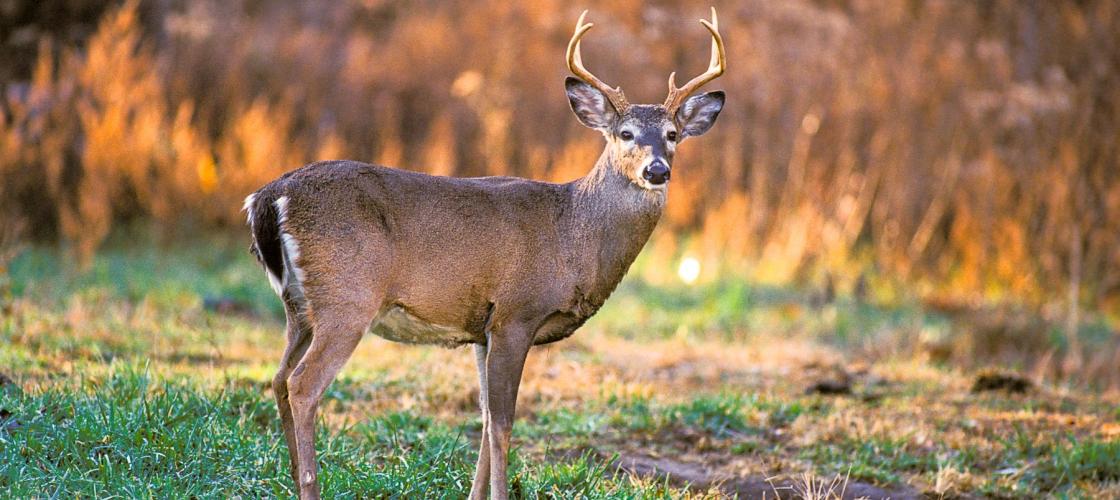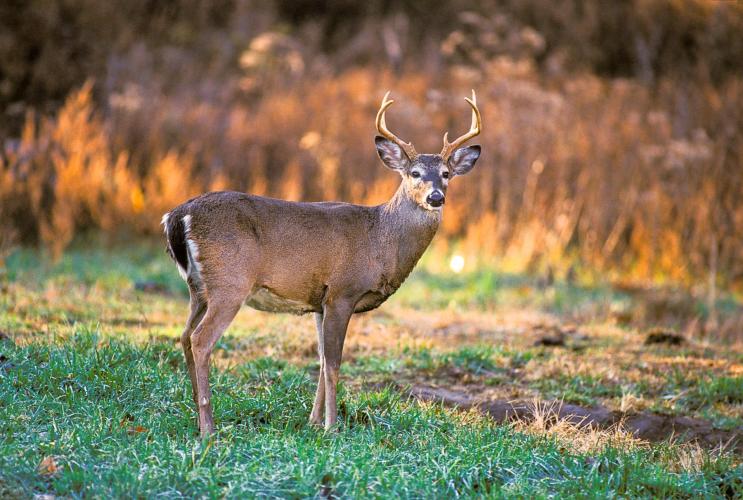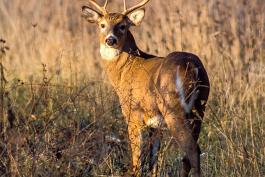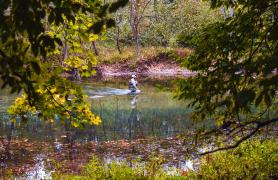
Chronic wasting disease (CWD), a fatal illness for white-tailed deer, continues to linger in pockets in Missouri and appear in new places. But detected cases remain limited. An epic nine-year effort by MDC staff, hunters, landowners, taxidermists, locker plants, and other partners has slowed CWD’s spread and kept the state’s overall deer herd healthy. The disease has been detected in only 18 of the state’s 114 counties, and CWD case numbers are limited in counties with detections.
“We’re determined to protect Missouri’s white-tailed deer for wildlife watchers and hunters, both for today and the future.”
Sara Parker Pauley,
MDC Director
“We’re determined to protect Missouri’s white-tailed deer for wildlife watchers and hunters, both for today and the future,” said MDC Director Sara Parker Pauley. “Healthy deer signify healthy ecosystems, and deer hunting is important to families for food and family traditions.”
Conservation brought Missouri’s deer herd back from the brink of extinction starting in the 1930s. Today, deer hunting contributes $1 billion annually to the state’s economy and deer are part of what makes wild Missouri valuable to tourism.
Yet, CWD remains a long-term threat to white-tailed deer. The transmissible brain-degenerative disease is caused by misshapen cell proteins called prions and is fatal to cervids, such as deer and elk. Scientists have learned a lot in the 40 years since CWD was first discovered in wild deer in Colorado; however, there are many mysteries yet to unravel. Researchers are working to discover better ways to prevent, detect, and control the disease, a task difficult because it involves free-roaming wild animals. MDC is contributing to that research.
Missouri’s campaign against CWD will continue this fall through the deer hunting seasons and the late winter of 2022. Fortunately, there is evidence that MDC’s extensive testing to detect the disease before it is widely established, and reducing deer numbers in an infected area, will keep the state’s overall deer herd healthy for wildlife watching and hunting.
“When you compare our deer herd to other states where CWD is widely established, most of our deer are not yet affected by the disease,” said Jasmine Batten, MDC wildlife health program supervisor. “But we certainly need to continue to effectively manage CWD because we’re not out of the woods yet.”
Research Brings New Hopes
CWD management will be a long-term process, but biologists and scientists are hopeful that new developments and analysis of gathered data can help.
“We’re evaluating our data from the last nine years,” Batten said. “We’re asking how effective our methods have been, especially post-season targeted culling, to see if there are things we could or should be doing differently going forward.”
One of the biggest challenges to CWD research has been limitations in current testing technology. Current testing is reliable but requires the lymph nodes from a dead deer, and standard methods to detect prions in the environment are not readily available. MDC is partnering with University of Missouri (MU) researchers in the College of Engineering and College of Veterinary Medicine Diagnostic Laboratory to develop more efficient methods of detecting prions.
There are two key components to the project. Both involve sophisticated science. One is launching an in-vitro amplification technology called real-time quaking induced conversion (RT-QuIC), which amplifies prion presence to improve detection. A second path being developed at MU is a novel biosensor device that can detect prions in an entirely new way. These new developments could lead to better access to testing, faster test results for hunters, and easier and more reliable methods for testing environmental samples and blood or other tissues. Ultimately, testing advancements will give researchers tools to better understand how CWD is spreading in the environment and more efficient controls.
These methods are not yet advanced enough for field use. But there’s hope.
MDC is also reaching out to landowners in CWD core areas that are within 2 miles of confirmed CWD detections. A two-year focus group project with landowners will start this year to see how CWD efforts can better serve their needs as well as wildlife.
“We’re looking for new and better ways to engage with landowners and help them participate in CWD management,” Batten said.
Proactive Detection and Prevention
MDC collects samples of deer lymph nodes to test for CWD. If CWD is detected, special regulations for that area are implemented. They include additional deer harvest allowances, mandatory sampling during the opening weekend of firearms deer season, carcass movement restrictions, and year-round prohibition of feed and minerals for deer that can concentrate them in one area. After hunting seasons conclude, MDC staff and property owners also use targeted culling in core areas to remove potentially infected deer and slow disease spread to new areas. Venison from deer with a “not detected” CWD test result is used by landowners or donated to the Share the Harvest program that provides food for needy families.
Some states with significant CWD cases have not implemented similar practices. Studies in infected states without controls have found a rise in CWD prevalence among deer, more older deer and larger bucks dying from the disease, and sometimes an overall deer population drop. CWD can eventually take a toll on deer numbers and quality of bucks harvested.
“We definitely value where we are in Missouri at this point,” Batten said. “Our agency is still committed to limiting the presence of CWD on the landscape. The majority of our hunters are concerned about CWD and support actions to slow its spread. What we do know is that without intervention, the disease will continue to spread and spread.”
MDC has used various monitoring methods throughout the state prior to and after the first CWD detection in free-ranging deer in Macon County in 2012. That includes mandatory sampling of hunter-harvested deer during the first weekend of firearms deer season in CWD management zone counties, voluntary sampling by hunters submitting deer statewide, and tissues provided for testing by partners such as taxidermists and meat processing businesses.
COVID-19 precautions precluded mandatory sampling during the opening weekend of the 2020 firearms deer season. That caused the number of deer tested to drop by 16,000 compared to more than 32,000 during the 2019–2020 surveillance year. But voluntary testing and samples provided by partners still provided a good overview for 2020–2021. MDC collected and tested more than 15,300 tissue samples, confirming 44 new cases. Meanwhile, hunters harvested 300,000 deer statewide.
“We’re sustaining our surveillance,” Batten said. “We can’t detect every case. But we are reasonably confident we know where it is in the state. When we do detect the disease in a new area, it is a low prevalence, showing we are detecting the spread early.”
Current Deer Seasons
Mandatory sampling will resume for hunters who harvest deer from the CWD management zone on Nov. 13–14 the opening weekend of the fall firearms deer season. MDC is monitoring the COVID-19 surge in the state and contingency plans are in place if health precautions prompt changes. Management zones include counties where CWD has been detected and counties within 10 miles of a detection site.
Currently, hunters who harvest a deer Nov. 13–14 in the CWD management zone must take the deer to one of the MDC sampling stations on the day of the harvest. MDC will notify the public if COVID-19 health precautions prompt a change. Management zones cover 34 counties in the north central, east central, west central, and southwest corners of the state. Hunters can later find out for free if the deer tested positive or negative for CWD. Science has found no cases of transfer of CWD from deer to people, but as a precaution, the Centers for Disease Control recommends that hunters in areas known to have CWD test their deer and that people not eat meat from an animal that tests positive for the disease.
Voluntary sampling is also available for deer harvested during other firearm, archery, youth, and alternative methods hunting seasons. Hunters harvesting a deer from a CWD management zone county are encouraged to do voluntary testing. Testing opportunities include partnering taxidermists and meat processors, designated MDC offices, and self-serve freezers where hunters can leave deer heads.
Statewide Team Effort
MDC coordinates CWD management in Missouri. But partners such as landowners are essential to success.
“We are so grateful for all their help,” Pauley said. “They’ve made it possible to limit CWD and protect deer for the future.”
Special deer hunting regulations for CWD are designed to help control the disease in the state’s deer herd, and they’re doing that, Batten said.
“But we’re especially grateful for the partnerships with hunters, taxidermists, landowners, and others to help fight this disease,” she said. “We’re really in this for the long haul, and there are a lot of people working on it.”
- Mandatory sampling is required for deer harvested Nov. 13–14 from CWD management zone counties. The sampling must be done on the day of harvest at an MDC sampling station.
- Voluntary CWD sampling is available for deer harvested by hunters throughout the various deer hunting seasons.
- Whole carcasses, heads, and certain other parts of a deer harvested in a CWD management zone can be removed from the county of harvest only if they are delivered within 48 hours to a licensed taxidermist or meat processor. The exception is that deer harvested during the mandatory sampling period Nov. 13–14 are taken to an MDC sampling station. This restriction is designed to limit accidental movement of CWD from one region of the state to another via carcass transport.
- CWD test results for hunter-harvested and sampled deer will be available online at mdc.mo.gov/cwdtestresults. Results time may vary, but results are typically available within three weeks from the time samples are submitted to MDC.
- The use of grain, salt products, minerals, and other consumable products to attract deer is prohibited year-round within CWD management
- zone counties.
- Deer harvested in CWD management zone counties may be donated to Share the Harvest only if they are tested for CWD and taken to a processor participating
- in the CWD Share the Harvest testing program.
- For more information, visit mdc.mo.gov/cwd.
| County | Number |
|---|---|
| Cedar | 1 |
| Cole | 1 |
| Crawford | 1 |
| Mercer | 1 |
| Pulaski | 1 |
| Putnam | 2 |
| Perry | 3 |
| Stone | 4 |
| Taney | 4 |
| Polk | 8 |
| Jefferson | 9 |
| St. Clair | 9 |
| Oregon | 10 |
| Asair | 21 |
| Franklin | 24 |
| Linn | 25 |
| Ste. Genevieve | 35 |
| Macon | 47 |
| TOTAL | 206 |
Limiting chronic wasting disease in Missouri deer












Also In This Issue

Experience fall by floating and fishing your way down an Ozark stream

Photographs, observations, and reminiscences
And More...
This Issue's Staff
Stephanie Thurber
EDITOR
Angie Daly Morfeld
ASSOCIATE EDITOR
Larry Archer
PHOTOGRAPHY EDITOR
Cliff White
STAFF WRITERS
Bonnie Chasteen
Kristie Hilgedick
Joe Jerek
DESIGNERS
Shawn Carey
Marci Porter
PHOTOGRAPHERS
Noppadol Paothong
David Stonner
CIRCULATION MANAGER
Laura Scheuler






















